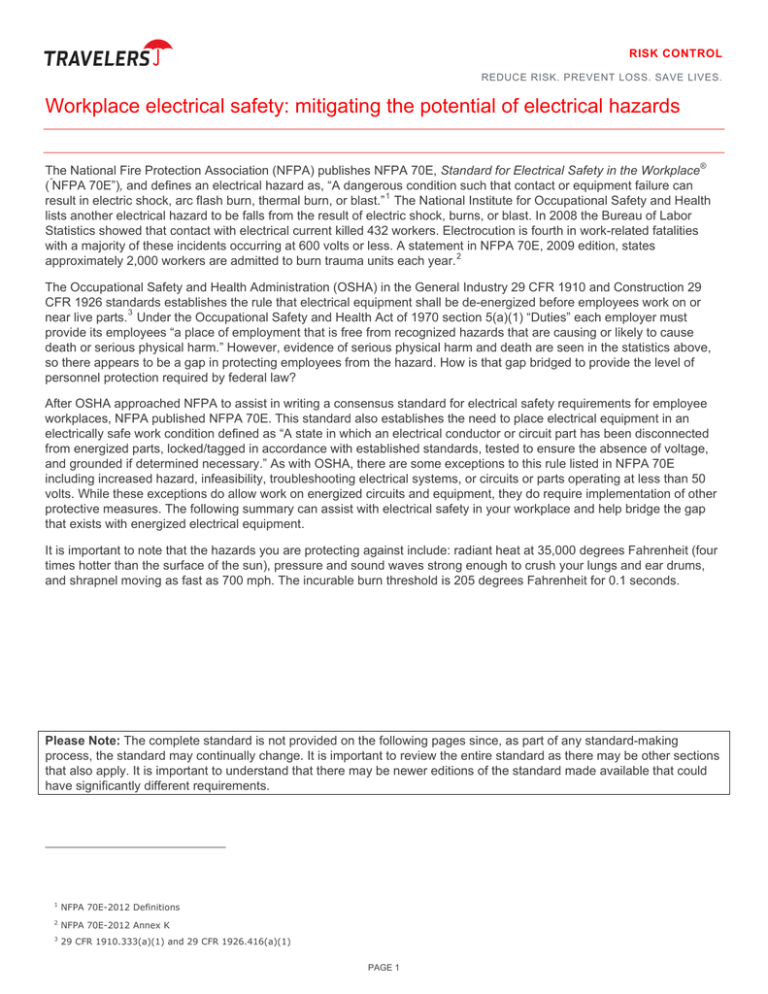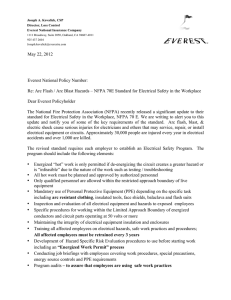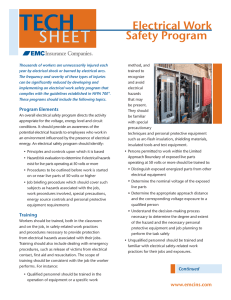
RISK CONTROL
REDUCE RISK. PREVENT LOSS. SAVE LIVES.
Workplace electrical safety: mitigating the potential of electrical hazards
The National Fire Protection Association (NFPA) publishes NFPA 70E, Standard for Electrical Safety in the Workplace®
(“NFPA 70E”), and defines an electrical hazard as, “A dangerous condition such that contact or equipment failure can
result in electric shock, arc flash burn, thermal burn, or blast.” 1 The National Institute for Occupational Safety and Health
lists another electrical hazard to be falls from the result of electric shock, burns, or blast. In 2008 the Bureau of Labor
Statistics showed that contact with electrical current killed 432 workers. Electrocution is fourth in work-related fatalities
with a majority of these incidents occurring at 600 volts or less. A statement in NFPA 70E, 2009 edition, states
approximately 2,000 workers are admitted to burn trauma units each year. 2
The Occupational Safety and Health Administration (OSHA) in the General Industry 29 CFR 1910 and Construction 29
CFR 1926 standards establishes the rule that electrical equipment shall be de-energized before employees work on or
near live parts. 3 Under the Occupational Safety and Health Act of 1970 section 5(a)(1) “Duties” each employer must
provide its employees “a place of employment that is free from recognized hazards that are causing or likely to cause
death or serious physical harm.” However, evidence of serious physical harm and death are seen in the statistics above,
so there appears to be a gap in protecting employees from the hazard. How is that gap bridged to provide the level of
personnel protection required by federal law?
After OSHA approached NFPA to assist in writing a consensus standard for electrical safety requirements for employee
workplaces, NFPA published NFPA 70E. This standard also establishes the need to place electrical equipment in an
electrically safe work condition defined as “A state in which an electrical conductor or circuit part has been disconnected
from energized parts, locked/tagged in accordance with established standards, tested to ensure the absence of voltage,
and grounded if determined necessary.” As with OSHA, there are some exceptions to this rule listed in NFPA 70E
including increased hazard, infeasibility, troubleshooting electrical systems, or circuits or parts operating at less than 50
volts. While these exceptions do allow work on energized circuits and equipment, they do require implementation of other
protective measures. The following summary can assist with electrical safety in your workplace and help bridge the gap
that exists with energized electrical equipment.
It is important to note that the hazards you are protecting against include: radiant heat at 35,000 degrees Fahrenheit (four
times hotter than the surface of the sun), pressure and sound waves strong enough to crush your lungs and ear drums,
and shrapnel moving as fast as 700 mph. The incurable burn threshold is 205 degrees Fahrenheit for 0.1 seconds.
Please Note: The complete standard is not provided on the following pages since, as part of any standard-making
process, the standard may continually change. It is important to review the entire standard as there may be other sections
that also apply. It is important to understand that there may be newer editions of the standard made available that could
have significantly different requirements.
1
NFPA 70E-2012 Definitions
2
NFPA 70E-2012 Annex K
3
29 CFR 1910.333(a)(1) and 29 CFR 1926.416(a)(1)
PAGE 1
RISK CONTROL
Workplace electrical safety: mitigating the potential of electrical hazards
1. Establish Responsibilities in the Workplace
a. Employers
i.
Provide safe work practices
ii.
Train employees who will implement the practices
b. Employees
i.
c.
Implement the safe work practices established
Contract Relationships
i.
Host employers inform contract employers of hazards and specific information of the current installations and
report observed contract employer violations to that employer
ii.
Contract employers instruct employees in hazards from host and according to NFPA 70E, verify employees
follow the requirements and notify the host of unique hazards presented and unanticipated hazards
encountered, and update on correction of violations
2. Training
a. Provide training for both qualified and unqualified at-risk workers in the hazards of electrical energy, safe work
practices and the potential injuries from the electrical energy
b. Employers provide and certify the annual emergency training, including CPR, methods of release when an
employee has come in contact with energized circuits, and automatic external defibrillator (AED)
c.
Retrain when observations warrant the need, equipment changes, when work practices are not part of the normal
work task, or annually
d. Document the training
3. Electrical Safety Program
a. Implement and document the program, designing it to build awareness and self-discipline while instilling the
safety principles and controls to direct activity appropriate for the electrical hazard
b. Establish procedures for working in specific boundaries where an electrical hazard exists. These include the Arc
Flash Boundary and the three Shock Boundaries, described as limited, restricted, and prohibitive
c.
Establish a procedure to evaluate the hazard/risk of working within these protective boundaries
d. Establish a job briefing to be used before starting each job presenting electrical hazards, modifying the brief for
repetitive and routine tasks
e. Set up a system to audit the program, and the work being performed in the field
4. Protective Measures
a. Place and verify energized electrical conductors or circuits are in an electrically safe work condition
i.
ii.
iii.
iv.
v.
Determine all possible sources of electrical supply
Interrupt the load current (use proper personal protective equipment (PPE))
Visually verify all disconnecting devices are open or withdrawn
Apply lock and tag
Use adequately rated voltage detector to test each phase conductor or circuit part to verify
deenergization
vi. Where possibility of induced voltages or stored electrical energy exists, ground system
PAGE 2
RISK CONTROL
Workplace electrical safety: mitigating the potential of electrical hazards
b. When energized conductors or circuit parts are not placed in an electrically safe condition due to the justification
of the greater hazard, infeasibility (troubleshooting),or equipment is less than 50 volts, perform both the Shock
and Arc Flash Hazard Analysis, establish an Energized Electrical Work Permit, restrict unqualified persons from
the work area, and allow only qualified persons protected to work on those conductors or circuits with the
appropriate PPE, insulated tools, and work practices, including the override of safety interlocks
i. Note: no Energized Electrical Work Permit is required for troubleshooting activities
5. Equipment
a. Test Equipment
i.
Use only rated test equipment for the work. The ANSI/ISA 61010-1 Standard, Safety Requirements for
Electrical Equipment for Measurement, Control, and Laboratory Use – Part1: General Requirements,
establishes the rating requirements and the instruments must have a CAT (category) rating of 1-IV. CAT III
and IV for the rated voltage are used for distribution and services respectively. Inspect the instruments
visually before each use and verify the instrument is working by measuring a known source both before and
after the required use
b. Portable Electrical Equipment
i.
Handle with care, verify grounding is present
ii.
Inspect before each use for defective equipment, proper ratings, and conductivity of the work area
iii. Test Ground Fault Circuit Interrupter protective devices per the manufacturer’s recommendation and
instruction
iv. Never modify overcurrent protective devices
6. Follow the guideline of NFPA 70E Article 120, Establishing an Electrically Safe Work Condition, until the process has
been completed to verify the absence of voltage. Reference to steps listed in 4a.
7. Work Involving Electrical Hazards
a. What is the justification to allow energized work?
i.
Greater hazard, not lack of planning
ii.
Infeasibility, not inconvenience, which includes testing and troubleshooting
iii. Less than 50 volts, but this does not guarantee safe work conditions
b. If justified, require energized electrical work permits with approval signatures of authorizing or responsible
management, which details the work description, justification for work, required safe work practices, results of the
shock and arc flash hazard analysis, the arc flash protection boundary, the PPE to safely perform the task, means
to restrict unqualified workers from the work area, and evidence of a job briefing
i. The Arc Flash Hazard Analysis shall be updated at least every five years or after major modification or
renovation of the electrical system, unless the system is 240 volts or less, served by a single transformer
rated less than 125 kVA or conditions exist that allow for the use of the Hazard/Risk Category Classifications
found at NFPA 70E-2012 Table 130.7(C)(15)(a). This requires information on the available fault currents and
opening time of the overcurrent protective device to be within the limits identified in the notes at the end of the
Table
c.
Establish approach boundaries (Reference NFPA 70E-2012 Table 130.4 (C) (a) & Table 130.4(C)(b). Select the
appropriate PPE rated in Hazard Categories 0 through 4, label the equipment with the incident energy level or
required level of PPE, verify only qualified person perform testing work within the Limited Approach Boundary
PAGE 3
RISK CONTROL
Workplace electrical safety: mitigating the potential of electrical hazards
d. Follow established requirements and approach distances for uninsulated overhead power lines (column heading
Exposed Movable Conductor in table 130.4 (C) (a) & (b), including requirements for unqualified persons, vehicles,
and mechanical equipment
e. Set other precautions based on alertness, blind reaching, illumination, wearing of conductive articles, use of
conductive tools, material, and equipment, confined spaces, housekeeping duties, use of flammable materials,
the anticipation of electrical equipment failure, routine opening and closing of circuits, and the establishment of
qualified person verifying and circuit protective devices before resetting a tripped circuit protective device
f.
Protective Equipment
i.
Provide PPE, covering all body parts, for all personnel working in the Arc Flash Boundary verifying the
clothing is flame-resistant (FR) rated for the determined Hazard/Risk and that all under layers of FR clothing
and the clothing for Hazard Risk Category 0 are nonmelting or untreated natural flammable materials
ii.
Inspect, store, and clean the FR clothing per the manufacturer’s instructions
Establish your Electrical Safety Program, train personnel, assess the hazards presented by the electrical energy, and
provide for the principles of the current edition of NFPA 70E, with the first and foremost rule to place any energized
electrical conductor or circuit part in an electrically safe condition before allowing work to begin. Then only allow workers
who are fully protected for the presented hazard to work on energized equipment after it as been determined that it is truly
infeasible to de-energize or creates a greater hazard. Convenience should not override safety. Following NFPA 70E can
help you bridge the gap of safe work practices when electricity is involved.
For more information, log in to the Risk Control Customer Portal at travelers.com/riskcontrol. (Need help? Read
our Registration Quick Guide.) You also can contact your Risk Control consultant or email Ask-RiskControl@travelers.com.
travelers.com
The Travelers Indemnity Company and its property casualty affiliates. One Tower Square, Hartford, CT 06183
The information provided in this document is intended for use as a guideline and is not intended as, nor does it constitute, legal or professional advice. Travelers does not
warrant that adherence to, or compliance with, any recommendations, best practices, checklists, or guidelines will result in a particular outcome. In no event will Travelers or
any of its subsidiaries or affiliates be liable in tort or in contract to anyone who has access to or uses this information. Travelers does not warrant that the information in this
document constitutes a complete and finite list of each and every item or procedure related to the topics or issues referenced herein. Furthermore, federal, state or local
laws, regulations, standards or codes may change from time to time and the reader should always refer to the most current requirements. This material does not amend, or
otherwise affect, the provisions or coverages of any insurance policy or bond issued by Travelers, nor is it a representation that coverage does or does not exist for any
particular claim or loss under any such policy or bond. Coverage depends on the facts and circumstances involved in the claim or loss, all applicable policy or bond
provisions, and any applicable law.
©2009-2013 The Travelers Indemnity Company. All rights reserved. Travelers and the Travelers Umbrella logo are registered trademarks of The Travelers Indemnity
Company in the U.S. and other countries. A0323
PAGE 4





